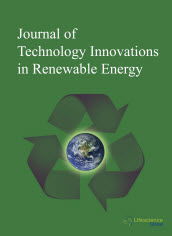jtire
|
|
|
Abstract: Lignin depolymerisation has recently a great deal of attention from scientists and companies worldwide due to the extensive possibilities of this recalcitrant material for the production of chemicals, fuels and materials. The natural complexity and stability of lignin bonds makes lignin depolymerization a highly challenging task. Several efforts have been directed towards a more profound understanding of the structure and composition of lignin in order to devise pathways and selectively cleave bridging bonds to break down the biopolymer into useful compounds. The present contribution aims to provide a series of key points in the field of lignin depolymerisation to provide an overview to the field for starting researchers. Keywords: Lignin, depolymerisation, heterogeneous catalysis, chemicals, fuels, materials.Download Full Article |
|
|
|
Abstract: The energy security issue has been paid close attention by many countries owing to the rising energy demand, the limited energy reserve, and the climate change problem. In spite of the broad concern, there is no globally accepted definition of energy security because, for any country, the impact of energy insecurity is highly correlated with its economic status, its resource endowment, its geopolitical partnership, as well as many other nation-specific features. Therefore, by using some of the world's largest energy consuming nations as examples, this article reviews the definitions of energy security and discusses the strategies to enhance it, in order to provide insight for policy makers from different countries. The results find that major energy consuming countries take measures to improve energy security status primarily by improving energy self-sufficiency and increasing energy diversification. Besides, this study also provides suggestion for different countries to take part in international energy cooperation in order to achieve a Pareto improvement of their energy security statuses. Keywords: Energy security, energy consuming country, international energy cooperation. Download Full Article |
|
|
|
Abstract: Portable Solar Water Distillation (PSWD) system can provide drinking water and hot water simultaneously to households. It utilizes solar radiation to heat the water and produce fresh water out of the saline or brackish water & also produce hot water. The paper focuses mainly on field performance of a new design of PSWD for domestic applications in remote and hilly areas. Field Performance data of PSWD system has been recorded during summer and winter in northern region. It is observed that on Solar Global Radiation 2.3 kWh/ 0.25 m2, maximum output of distilled water generation of 1.2 liters/day per 0.25 m2 was achieved and average temperature of hot brackish water has reached 420C at ambient temperature of 230C within 8 hours. This system is the most efficient and cost effective. It can produce pure, clean fresh water along with hot brackish water from any water source. Keywords: Solar energy, mathematical modelling of PSWD system, hot brackish water.Download Full Article |
|
|
|
Abstract: Solar updraft power technology (SUPT) forms a highly innovative, modern and efficient concept for solar-based electricity generation. Solar updraft power plants (SUPPs) are fueled purely by solar irradiation. They require no water for power generation, so their ideal locations are deserts. A SUPP consists of the glass-covered collector area (CA), in its centre the solar chimney (SC), and around the SC’s perimeter the power conversion units (PCU). This arrangement causes a permanent flow of warm air through the SUPP, producing electricity. The paper describes computer simulation concepts to evaluate the power/energy harvest in such plants, based on fluid-thermodynamics and radiation-physics. The nonlinear numerical processes for the SUPPs’ power harvests are solved by fast computer algorithms. Finally, the high economy of SUPT for world-wide arid zones in terms of leveled electricity costs (LECs) is exemplified by several optimized SUPPs. Keywords: Solar updraft power technology, multi-physics computer simulation, thermo-fluiddynamics, low-concentrated solar power, cost-efficient electricity.Download Full Article |
|
|
|
Abstract: In this study, an interval two-stage integer programming model is formulated for planning electric-power systems and managing carbon dioxide (CO2) emissions under uncertainty. The developed model can reflect dynamic, interactive, and uncertain characteristics of regional energy systems. Besides, the model can be used for answering questions related to types, times, demands and mitigations of energy systems planning practices, with the objective of minimizing system cost over a long-time planning horizon. The developed model is also applied to a case study of planning CO2-emission mitigation for an electric-power system that involves fossil-fueled and renewable energy sources. Solutions can help generate electricity-generation schemes and capacity-expansion plans under different CO2-mitigation options and electricity-demand levels. Different CO2-emission management policies corresponding to different renewable energy development plans are analyzed. A high system cost will increase renewable energy supply and reduce CO2 emission, while a desire for a low cost will run into risks of a high energy deficiency and a high CO2 emission. Keywords: CO2 emission, electric-power systems, optimization, planning, renewable energy, uncertainty analysis.Download Full Article |



